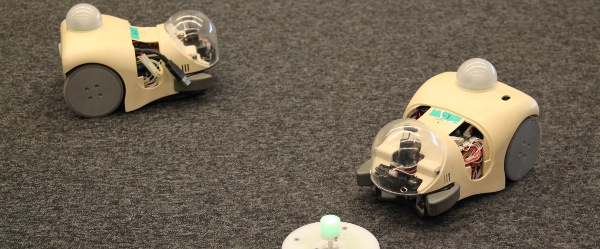
Researchers at the Okinawa Institute of Science and Technology (OIST), Japan, have created mice-shaped robots that have sex with each other.
The OIST Neural Computation Unit has been using the robots to help gain a better understanding of evolution.
Stefan Elfwing, a researcher in Professor Kenji Doya’s Unit, has successfully used a colony of the rodent-like robots to watch different mating strategies evolve. The work not only generated interesting and unexpected results, but it has also helped validate the use of robots in the study of evolution, he explained.
By using robots and computer simulation, Elfwing is able to watch evolution happen over 1,000 generations in a short period of time – something that is impossible to do in live animals.
Elfwing programmed a small colony of Cyber Rodent robots, which have two wheels, a camera to detect batteries and other robots, electrode teeth to recharge from batteries, and an infrared port for ‘mating’, which is to copy their ‘genes’, or the essential parameters of the programme. The robots can execute two basic behaviors: foraging for a battery and searching for a partner to mate.
The experiments were run in computer simulation to observe the evolutionary process over 1,000 generations in each experiment. In the situation when both a battery and the tail of another robot are visible, two main phenotypes in mating strategies emerged.
First, a Forager that only went for the battery and would never wait for the partner to turn around for mating. It would only mate when it saw the face of a potential mate. Secondly, a Tracker that would wait for the mating partner to turn around for mating. The interesting result to come out of some of the 70 experiments was a polymorphic population where these two different mating strategies, or phenotypes, co-existed within one population. By running experiments with different ratios of the phenotypes, he further showed that there was a stable mixture ratio of 25% Foragers and 75% Trackers.
The evolution of two distinct mating strategies is similar to what is seen in the wild. In some experiments, only one strategy would evolve in the population. However, in the experiments where polymorphic populations evolved, the robots had some of the highest fitness, or fastest reproduction, out of all of the experiments. This indicates that the presence of these different mating strategies in certain proportions provided the best chance for proliferation.
Elfwing said: "In this experiment, our robots were hermaphrodites, all robots mate and can produce offspring. In the next stage, we want to see if the robots will take on male and female roles, by taking different risks and costs in reproduction. The behavior exhibited by the two strategies, Forager and Tracker, may be a precursor to the adoption of distinct genders."






